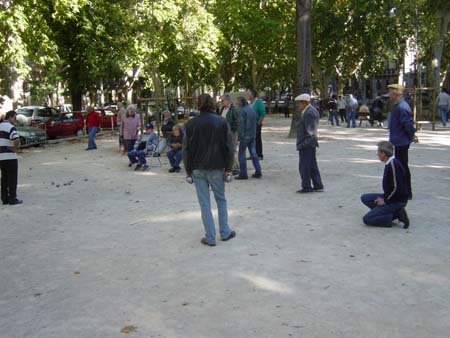Wednesday, October 8
Steve: We spent the afternoon at Nimes, which is located
only 20 minutes from where we're staying near Arles. Nimes is best known for
its Roman architecture, but we were also very pleasantly surprised by its
lovely parks and open areas. 
We started at the Roman amphitheater, which is similar in size to the one
here at Arles but is considered to be the best preserved of all the remaining
amphitheaters. It seats 24,000 people and was built in around 90 AD. After
the collapse of Rome, it became a fortress and a headquarters for knights.
During much of the Middle Ages, the amphitheater served as a slum and held
over 2,000 people, many of whom were looking for refuge during times of danger.

We were very interested to learn of the wide variety of uses for the amphitheater today. It's considered a highly desirable venue, and hosts many types of events including theater, opera, concerts, Davis Cup tennis, fashion shows, world championships for fencing and archery and ice skating. During the summer months, its most common use is for both Camargue and Spanish-style bullfights (in the Camargue version, the bull is not killed).
Today, they were working on installation of a winter roof that has been used
since the late 1990's to allow for events in the amphitheater on a year-round
basis. This explains the equipment that appears in our pictures.
We then walked through the center of Nimes' old city. Given the relatively
large size of Nimes (compared to the other towns near here), we were surprised
to find this to be such a nice area. There are many narrow, winding streets
lined with shops and restaurants. One difference is the nature of the stores
- here we saw many name-brand shops (Mephisto, Claire's Accessories, Bennetton,
etc.) instead of the smaller locally-owned stores that we visited yesterday
in Uzes. 
We made our way toward the Maison Carree, a small Roman Temple located in
the heart of Nimes. The temple is considered to be the best preserved temple
in the Roman world, and stands in the middle of a public square surrounded
by modern buildings (including the Carrie d'Art modern gallery). Maison Carree
has been used almost continually since the 11th Century, serving as a consular
house, an apartment, a stable, a church, military headquarters and finally
a museum. This explains its impressive state of preservation. We enjoyed learning
about its history, and in particular walking through the square and viewing
the contrast between the temple and the surrounding buildings.
Our next stop was the Jardin de la Fontaine, a wonderful open park that reminded
us of some of the larger parks in Paris. At the entrance to the park we found
a set of very intense "boules" (what we call bocce ball) matches
in progress. It looked like a tournament, and we admired the men and their
skills. Each player had his own style - some bowled from their knees, and
others had their own little routines, almost like a tennis player who is getting
ready to serve. There were signs indicating that certain areas were reserved
for "veteran boules" players - this is serious stuff!
We walked through the park and to the top of Mont Cavalier. Here we climbed the Tour Magne, the largest remaining tower from the Roman wall that originally surrounded Nimes. It dates from 15 BC, and the view of Nimes from the top was wonderful today.
Tomorrow we understand that it's supposed to be calm and warm, so we plan to spend the day exploring the Camargue.
Distance Walked: 2.28 miles


